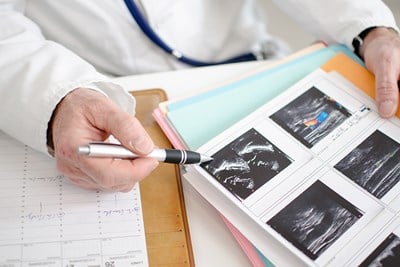There are three main forms of spina bifida. In ascending order of severity and prevalence, they are spina bifida occulta, meningocele and myelomeningocele. Individuals born with spina bifida occulta, the mildest and most common form, are often asymptomatic; individuals with the most severe and rare form, myelomeningocele, have profound symptoms such as paralyzation. Symptoms of spina bifida are neurological in nature and can be grouped into four broad categories: spinal deformity, bladder and bowel problems, impaired mobility, and intellectual difficulties. Here is a breakdown of the symptoms of spina bifida.
Spinal Deformity
Spina bifida is a birth defect of the vertebral spine. Those with spina bifida occulta often exhibit no symptoms at all. However, if they do show symptoms, it's only in physical relation to the spinal deformity. For example, they may have a small dimple or birthmark on the skin above the vertebral malformation. Other observable symptoms may include an abnormal tuft of hair or fat node above the deformity. More often than not, spina bifida occulta is only detectable through imaging.
Meningocele is a birth defect of the spinal column that includes the membranes that surround the spinal cord. However, the actual spinal cord and nerves are not included. A baby with a meningocele deformity is born with a fluid-filled sac that protrudes through a split spine. The sac is sometimes covered with a layer of thin skin, or it may be exposed.
Unlike spina bifida occulta and meningocele, the myelomeningocele spinal deformity involves the spinal cord and nerves. Through a separated portion of the vertebral column, a part of the spinal cord, nerves, and membranes protrude as a fluid-filled sac. Improper development or damage to the protruding spinal elements results in neurological problems related to bladder and bowel control, mobility, and intellectual capabilities.
Bladder and Bowel Problems
Spinal nerves control the sphincter muscles that enable urinary and bowel continence. Damage to them either limits one's ability to control urination and bowel movements or causes complete loss of control. Those with spina bifida whose nerves are damaged may be partially or completely incontinent. Urinary and bowel incontinence often leads to recurrent urinary tract infections, kidney damage, and sexual dysfunction.
Impaired Mobility
Nerve damage associated with spina bifida may also mean that individuals have little to no feeling in their lower limbs. In addition to sensation loss, nerve damage can result in problems controlling the leg muscles. Paralysis can even occur. Depending on the degree of weakness or paralysis in the lower limbs, a child may need to use splints, orthoses, or a wheelchair.
Muscle weakness affects bone development because muscles are the bones' support system. When bones lack muscle support, orthopedic abnormalities such as dislocated or deformed joints, bone fractures, scoliosis, and misshapen bones can occur, thus impairing mobility further.
Intellectual Difficulties
The intellectual difficulties associated with spina bifida are secondary to hydrocephalus—excess spinal fluid accumulation on the brain. Hydrocephalus damages the brain. Learning difficulties, especially in regards to self-organization and attention span, result.



